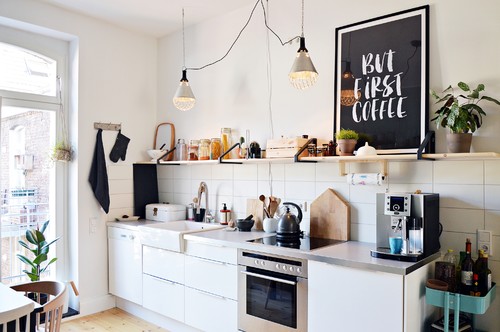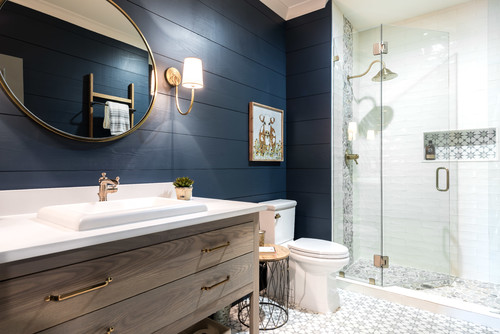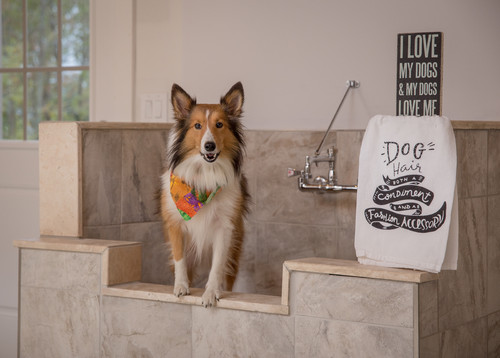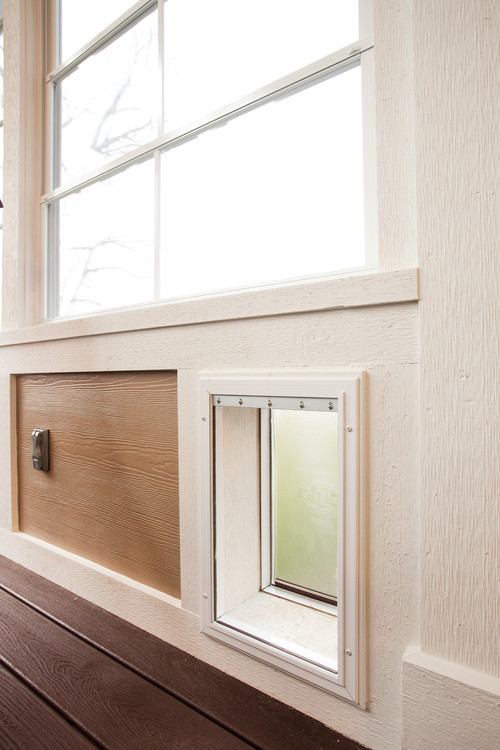Finding Homes for Home’s Best Friend


Nothing compares to the warmth and comfort of being at home. But for many dogs across America, this feeling is foreign.
According to The Humane Society, between six and eight million dogs and cats enter shelters each year. Plus, almost three million healthy shelter pets are not adopted annually, and only about 30 percent of pets in homes come from shelters or rescues.
These sobering facts are what served as the inspiration the Coldwell Banker Homes for Dogs Project. After more than 100 years of helping people find homes, the real estate company extended its mission to man’s best friend with its “Homes for Dogs Project.” By partnering with Adopt-a-Pet.com, North America’s largest non-profit pet adoption website, the Coldwell Banker network has helped to find more than 20,000 dogs their furever homes.
To increase awareness of the effort, Coldwell Banker has focused its latest advertising campaign called “Old Dog New Dog” to capture the heartfelt story of an agent giving back to her community by helping shelter animals find homes through the “Homes for Dogs Project.”
The commercial features rescue dogs, such as Max, who was adopted in 2014 after being spotted on Adopt-a-Pet.com. Before he was put up for adoption, Max was picked up as a stray and delivered to a “high kill” shelter in San Bernadino, CA. The shelter only keeps dogs for five days before it puts them down, and after Max had been at the shelter for four days, a worker reached out to The Dexter Foundation, a local non-profit dog rescue and adoption agency, which quickly rescued Max and found temporary foster care for him.
“I found him on Adopt-a-Pet.com as I was looking for a dog to rescue of that sort of breed and age,” said Kelly Saffrey, Max’s current parent. “As soon as I saw his picture, I just knew he was the pet for me.”
Adopt-a-Pet.com currently has more than 15,000 shelters and rescues in its network, and it is thrilled to be partnering with Coldwell Banker.
“We share Coldwell Banker’s view that nothing turns a house into a home more quickly than the addition of a loving pet,” said Abbie Moore, executive director of Adopt-a-Pet.com. “And we are so inspired by the desire of Coldwell Banker to launch this amazing program.”
For more information on the “Homes for Dogs Project,” head to coldwellbanker.com/homesfordogs
Source: CB Blue Matter Blog
How to Make Space for a New Pet at Home


Getting a furry friend is always an exciting time, however, it’s definitely a good idea to make a few tweaks to your home and take some precautions to ensure a happy, healthy life for the newest member of your family. Here are a few starter tips whether you’re getting a cat or dog.
In the kitchen. The biggest danger in the kitchen is when pets help themselves to toxic foods left out on the counter, or worse, from the trash. Just like humans, raw meat of any kind can be dangerous for them to ingest, as well as chocolate, onions and grapes. Some of the best ways to prevent them from eating human food are to keep counters clear, store food in hard-to-reach upper cabinets, use a pet-proof trash can and put up a pet gate during food prep and mealtime.
In the bathroom. Toilet bowl water is commonly contaminated with chemical cleaners, so you probably don’t want your pet drinking or falling into it. You can use the same toilet locks used with young children to prevent this. It’s also smart to keep bathroom counters clear of small accessories, such as hair ties, bobby pins, jewelry and makeup. Keep cleaning solutions, both here, in the kitchen and the laundry room, out of reach too. If you’re prone to keeping a dirty laundry pile in the bathroom, be sure to keep loose clothes off the floor so they don’t get torn or chewed up.
Lastly, especially for big dogs, you may want to consider integrating a pet washing station into the bathroom, mudroom or laundry room. This can be done by building out an entirely new setup or installing an extra ledge in an existing, spacious shower. Smaller dogs and cats can be easily washed in oversized utility or even kitchen sinks.
In the living room. One of the biggest concerns here is ensuring your pet doesn’t claw up your furniture. Leather and synthetic fibers are great options for sofas since they can easily be wiped clean, and carpet tiles are great alternatives to regular carpets and area rugs because you can replace any tile individually for a small price if it gets damaged.
Many pets love having a great view of the outdoors. If you have expansive windows nearby, set up a nice lounging area for them by putting a pet bed or cushion along a window seat. In addition to that, many pets also love cozying up by the fire. Be sure to protect them from getting hurt or burned by an open fire with a simple screen.
In the home office. Protect yourself against having to use the age-old excuse of “my dog ate my homework” by filing loose papers away in a cabinet or binder and away from pesky paws. Another concern here is exposed bundles of cords, which can electrocute your furry friend if they chew on them. Tuck them away or cover them with concealer cables, which have the added benefit of helping declutter your workspace.
Give them their own space. Although you’ll probably want to spend most of your day snuggling your pet, it’s also important to give them a space of their own. Their cozy corner can easily be integrated into any low-traffic zone such as the laundry room or garage where you can arrange their bed, favorite toys and food and water bowls. Crates and litter boxes have come a long way from their traditional bulky look and can now be hidden under a desk, integrated under the staircase or custom made to match your room design.
The great outdoors. Just like many of us, dogs and cats love basking in the sun and exploring nature. Consider installing a pet door so they can go in and out as they please. Add a fence or gate around your yard so they don’t run off and get lost. It’s also a good idea to have a boundary or cover for outdoor features, such as pools, ponds and fire pits, so they don’t fall in and injure themselves. Finally, exercise caution when planting garden favorites, such as daffodils, tulips and hydrangeas, since they can be toxic to dogs and cats if ingested.
Integrating technology. It’s always important to show your furry friend some love. If your budget allows, invest in one of these new technologies to keep your pet happy and healthy. Automatic pet doors that are linked to a device on your pet’s collar beat traditional versions by blocking wildlife, rodents and even snow or rain from coming in too. GPS smart collars also help keep your pet safe and able to locate in worst case scenarios. Lastly, automated water and food feeders are great alternatives to manual feedings, especially for people with busy lifestyles, and can even help your pet diet and lose weight.
Source: CB Blue Matter Blog
Helping Find Homes for Dogs in East Tennessee


Coldwell Banker Wallace & Wallace, Realtors® is participating in the National Pet Adoption Weekend and the Homes for Dogs Project during September by promoting adoptable dogs and holding a special “Homes for Dogs” Open House event on Sept. 10th.
Coldwell Banker Wallace & Wallace, Realtors® has been showing East Tennessee the way home for more than 80 years, and we’re excited to once again extend our mission to help find homes for dogs in our area.
Dogs Make a House a Home
Since 2015, the Homes for Dogs partnership with Adopt-a-Pet.com has helped find homes for thousands of deserving shelter dogs.
But it’s not just the dogs who benefit from being part of a loving home. There is research that shows how dogs can positively impact our psychological as well as physical health. It isn’t a coincidence that you feel better coming home to your dog after a long stressful day. Studies have found that during heart rate and blood pressure testing, patients were calmer and had better test results when a dog was present.
Plus the exuberance dogs show when you start to put on a pair of sneakers is a great motivator for enjoying more active time spent together outdoors.
Helping Dogs in East Tennessee
Coldwell Banker’s Homes for Dogs project is now in its third year, and at Coldwell Banker Wallace & Wallace, Realtors® in East Tennessee, we are ‘doggone’ happy to be taking part again.
All across the nation, real estate agents are doing their part to participate in the National Pet Adoption Weekend September 9th and 10th, 2017.
In Knoxville, we will be working with our local Adopt-a-Pet partner, the Humane Society of the Tennessee Valley. First, we’ll be promoting adoptable shelter dogs with our “10 Days of Dogs” campaign on social media. Beginning September 1st, a different shelter dog will be featured each day across all the company’s social media platforms. We hope that by helping to showcase some of these amazing furry friends, they will be that much closer to finding their forever homes.
We’re collecting items from the shelter’s wish list at each of our six area office locations. We have placed special donation containers in our office lobbies where consumers can drop off greatly appreciate items that we will deliver to the shelter. Click here to find a list of items needed by the shelter.
Finding Homes for All
Since we’re also in the business of finding homes for people, real estate agents at Coldwell Banker Wallace & Wallace, Realtors® will be holding a number of properties open on September 10th as part of this special event. We invite the public to visit any of our open houses that day and register to win one of six GPS pet trackers being given away. We’re hoping to help a few beloved pets make sure they always find their way back home. Consumers may also bring donated items for the shelter to any of our open houses on Sept. 10th.
Our company has been fortunate to be part of the community in East Tennessee since 1936. It has been our great honor to help thousands of our neighbors find their Knoxville home for more than 80 years. Many of our more than 350 sales professionals are passionate pet owners, and they look forward to taking part in this campaign to help find homes for dogs, our favorite four-legged friends.
Source: Coldwell Banker Blue MatterBlog
Coldwell Banker Offices Across America Team Up For National Adoption Weekend


Coldwell Banker and Adopt-a-Pet.com Host the Homes for Dogs National Adoption Weekend September 9-10, 2017
Su Amsden and Casey Lukowski with Coldwell Banker Coastal Alliance in Long Beach, California, have always had a love for animals. So when Coldwell Banker launched a program to help find homes for adoptable dogs three years ago, they immediately got to work on hosting an adoption event in their own community.
“It was a no-brainer,” Amsden said. “There are thousands of shelter animals who need homes. Adoption gives them a second chance at life.”
On September 9-10, 2017, hundreds of Coldwell Banker Real Estate offices and animal shelters across the country are joining Coldwell Banker Coastal Alliance for the Coldwell Banker Homes for Dogs National Adoption Weekend. The event is part of the “Homes for Dogs Project,” a program launched in 2015 by Coldwell Banker and Adopt-a-Pet.com, North America’s largest non-profit pet adoption website.
In 2015 alone, the project helped facilitate more than 20,000 adoptions through a national adoption weekend and countless local events like the ones Su and Casey hosted. Coldwell Banker made the “Homes for Dogs Project” the centerpiece of its advertising campaign to raise additional awareness. This past spring, the real estate brokerage dedicated its March 2017 commercial “Somebody to Love,” to the program, which was was applauded by the New York Times and rated one of the highest ranking ads of all time by Ace Metrix.
“Coldwell Banker is a unique position to touch local communities because of the sheer scope and passion of our network,” said David Marine, senior vice president of marketing, Coldwell Banker Real Estate LLC. “The ‘Homes for Dogs Project’ is more than just a campaign. It’s a unified movement that we can all rally around and know we are making a difference.”
Amsden and Lukowski agree. “Our event brings awareness to the community and is a great morale booster for the volunteers, most of whom are agents who work hard at what they do. This really brings joy to everyone involved,” said Lukowski.
Want to participate in the Homes for Dogs National Adoption Weekend? Visit: http://www.adoptapet.com/homesfordogs.
Home Safety: How to Protect Your Family at Every Stage of Life


Safety…ALWAYS a concern. Here are some really practical tips throughout a lifetime of staying safe. Good to know!
We all want to keep our families as safe as possible, but home safety requirements change as your family grows and evolves. From newborns to pets, a variety of different strategies can ensure your home is as safe and accommodating as possible for your family. Here are some simple tips to help keep your family safe through every stage of life.
Getting Your Home Ready for a New Baby
Babyproofing a home is largely about protecting them from their own curiosity. Once a baby learns to crawl, anything in reach is fair game to be grabbed, touched, or chewed on.
1. Install baby gates to keep certain rooms off-limits. This is especially important near stairs.
2. Fill unused electrical outlets with plastic plugs. Outlets are like magnets for babies.
3. Store breakable items out of reach.
4. Keep small items out of reach, as well. Small objects that could be put into mouths are a major choking hazard. A good rule of thumb is if it can fit in an empty toilet paper roll, it is small enough for a baby to choke on.
Home Safety for Toddlers and Elementary-Age Children
Toddler-proofing is a little different from babyproofing in that a toddler is usually more resourceful about getting into things they shouldn’t be. Toddlers will climb, open doors and drawers, and generally get themselves into trouble.
1. Move anything small or breakable up higher now that your child is walking and climbing. You’d be surprised at what they can reach.
2. If you have a pool, build a fence around it. You’ll want a barrier at least a few feet high to make it harder for your toddler to climb over.
3. Secure drawers and cabinets with childproof latches.
4. Place safety locks on windows and doors to prevent them from being opened.
5. If you don’t have a home security system, install one for added safety. Choosing a system with the right features, like motion sensors and security cameras, can help you know if your curious toddler runs out the door or it can help you keep tabs on things while the babysitter is over.
Safety During the Teenage Years
As your child grows into their teens, the focus moves further from physical safety and more towards online safety and general home security. Online safety is extremely important with teenagers in the house.
1. Set clear boundaries and expectations with your teen regarding potentially dangerous situations. These could involve simple subjects like safe driving or complex topics like drinking and drugs.
2. Keep alcohol, firearms, and any prescription or over-the-counter drugs locked up in a safe place.
3. Educate your teen about safe internet usage. This includes avoiding malware, being smart on social media, and using privacy settings.
Pet-Proofing Your Home
Pets make great additions to the family, but they come with their own safety needs. In many ways, pet-proofing is similar to babyproofing. Pet-proofing involves keeping harmful items out of their reach and making sure that they can’t escape the house or yard and run off.
1. Keep cleaning products, chemicals, and medications in high places or locked where pets can’t stumble upon them.
2. If your pet likes to chew on (or eat!) household items, make sure that you don’t leave anything lying around. It can be helpful to do a quick walkthrough of your home a couple times a day, such as when you leave and return from work.
3. If you have a home security system, make sure the motion sensors are capable of detecting and ignoring your pets.
4. If you have a fenced yard, check it for weaknesses or small gaps that a pet could squeeze through.
Getting Your Home Ready for Your Parents to Move In
As our parents get older, it’s not uncommon for them to move in with us. This can help ensure their safety and prevent the loneliness that often comes with old age. It can also present some unique challenges when it comes to home safety.
Depending on your parent’s age and their physical and mental well-being, you may need to make small home improvements for their convenience or physical safety. In general, you’ll want to try to minimize the potential for falls and make sure that help is always within reach.
1. Install grab bars in the bathrooms near the toilet and shower. These bars can help support a person as they move in and out of the shower or tub, both making this task easier and helping prevent falls. Make sure they can support the weight of the person who’ll be using them.
2. Walk through your home and check for objects that might make tripping hazards. Throw rugs, children’s toys, and pet toys can all be dangerous for people lacking the eyesight or reflexes to maneuver around them easily.
3. Set up a medical alert system. This is a wearable device that essentially functions as a panic button—if a person falls or has a medical emergency, they can push the button to get instant access to help.
4. Learn which foods are hazardous for senior health. As your parents age, their immune system weakens, making them more susceptible to food poisoning and health risks. Prepare meals at home that won’t threaten the health of your aging parents.
Your family grows and changes as time goes by, and so should your home safety plans. If you want to keep up with each of your family members, continually assess their needs. These tips should give you a great starting point towards building a safer home for your family.
Source: RisMedia

 Facebook
Facebook
 X
X
 Pinterest
Pinterest
 Copy Link
Copy Link

















